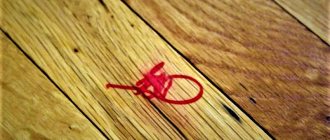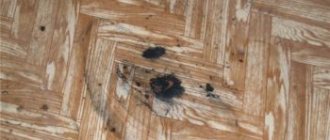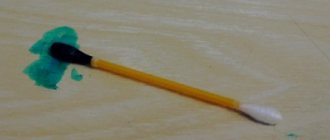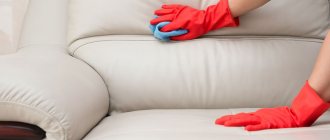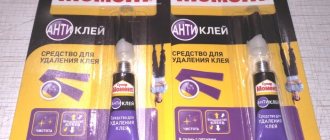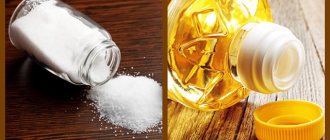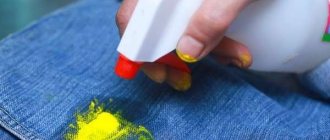Angelina
A week ago, a child splashed greenery in the kitchen. Seeing green specks all over the linoleum, I immediately began to figure out how to wipe off the green from the linoleum. I didn’t find any advice on the manufacturers’ websites, but I found a lot of recommendations on the forums.
There are a lot of tips on the Internet for removing green stuff. Most of them do not work, and in this article I will show this with real examples.
I tried seven methods and will share the results with you.
Preparatory stage
| Immediately blot a fresh stain from brilliant green with a paper napkin, rag or cotton pad . Remove as much of the green stuff as possible before it gets absorbed and dries, forming a hard-to-remove layer |
| Don't rub stains. This will increase the size of the stain, just blot and change sides of the napkin to remove all the liquid. Do not smear the brilliant green on the surface |
| Cover large stains from brilliant green on linoleum with salt. Make a layer of at least 5 mm so that the salt absorbs the liquid. Leave the composition on the surface for 2-3 minutes |
| Collect the salt that has absorbed the green stuff . Place a piece of paper and carefully sweep everything off the linoleum with a sponge |
Method 1: nail polish remover
We collect everything you need:
|
| Apply a little nail polish remover to a cotton pad. Carefully remove dirt using sweeping movements. Remove the brilliant green solution in order |
| Result of work. The flooring is perfectly clean. There is not even the slightest trace of green on it. Little time is spent, no effort required. |
Different types of linoleum: how to remove green stains from them?
Before you begin work on stain removal, you need to understand what material the floor covering is made of. Because the hard material is washed quickly enough, while the soft texture of linoleum requires some effort.
The means that will be used in the work also play an important role
- If the linoleum is baseless, then baking soda and vinegar will help clean it. Cleaners that contain alcohol should be used with extreme caution. But products with acetone and powders threaten to cause scuffs and holes in the coating, because this type of linoleum is very thin.
- The foam base of the floor covering makes it thicker (about 3.5 mm), so this covering can be removed with products that contain chlorine.
- Felt linoleum is the thickest type of flooring (up to 5 mm), but it can also be damaged if you use too aggressive products or forcefully clean it. First, the top protective layer will be erased, and then holes will appear in the remaining thickness of the material.
There are many ways to help remove green stains from flooring such as linoleum. But it is very important to start work right away. If the stains are too old and cannot be removed, then it is better to replace the linoleum.
Method 2: baking soda and vinegar
| Sprinkle some baking soda over the green stains . Cover contamination with a layer of at least 5 mm |
| Pour vinegar or acetic acid over baking soda. A reaction will begin with violent foaming. Add vinegar a little at a time until the baking soda foams. It is recommended to leave the liquid for a few minutes |
| Wipe off the dirt with a cotton pad or cloth . Some people advise using a soft brush, but I didn’t have one on hand |
| Result of work. I rubbed very hard, but I couldn’t wash off the brilliant green. The stain became lighter, but did not disappear. Re-processing did not improve the situation |
Which method to choose depending on the type of linoleum
When choosing the optimal method for cleaning brilliant green from a surface, it is worth considering the type of linoleum:
- The baseless material has a thickness of no more than 3 mm. It should not be treated with agents with an aggressive composition. The most suitable would be vinegar essence, baking soda, and products containing alcohol;
- Linoleum with a foam base tolerates any means well, it does not deteriorate even under the influence of chlorine;
- Options on felt should be cleaned with baking soda. After treatment, the surface is washed with water and wiped until dry.
Method 3: Eraser
| We take a hard rubber eraser and try to erase the brilliant green . Three firmly to remove dirt from the surface |
| Don't press the surface very hard . The elastic should be erased, but not damage the top layer of linoleum |
| Remove the eraser pieces . Check if the surface is damaged |
| Result of work. I rubbed until my hand got tired, but I couldn’t remove the stains from the linoleum. In 10 minutes a small edge was wiped off. I have structural linoleum. Maybe this method will work better in a smooth version |
Method 4: kerosene
We will prepare everything you need:
|
| Apply a small amount of kerosene to a cotton pad . Use moderate pressure to scrub the stain off the floor. |
| Result of work. The spots became a little lighter, but did not disappear. I tried pouring some kerosene on the stains first. The result is the same |
Method 5: solvent R-646
We prepare everything you need:
|
| Apply the solvent to a cotton pad . Soak the material well, this simplifies the work and speeds it up |
How to remove brilliant green from linoleum:
If the linoleum was fixed to the floor using cold welding, carefully use solvent on the seams. It eats away the adhesive |
| Result of work. The stain completely disappeared without any special effort or vigorous rubbing of the surface. The only negative is the strong smell of solvent. After removing stains, rinse the surface with warm water and a liquid cleaner. |
Green stains: radical methods for eliminating them
If none of the methods help get rid of antiseptic contamination, then you can resort to radical methods. But still, they should be used only in extreme cases, when the stain is in a visible place and spoils the appearance of the floor.
The area with the stain can be cut out and a new piece of linoleum glued on.
Radical cleaning methods include:
- The stained area can be carefully cut out. Afterwards, a clean piece is applied and secured. It works like a patch. To keep it firmly in place, you can use cold welding, and the pattern must be selected so that it matches exactly;
- A new piece of linoleum can be glued with double-sided tape. But it will look ugly, all the joints will stand out;
- In the room, you can rearrange the furniture and put a wardrobe, chest of drawers, or bed on the area with the stain. But it is worth assessing the situation; if the pollution is in the center of the room, then rearranging is unlikely to help;
- A carpet that can be laid in the room will help hide the stain. But you should be prepared for the fact that this product has a decent price.
Additionally, you can watch a video with options for cleaning brilliant green. They show different options for removing contamination; they will help clean even old linoleum or parquet, maintaining its quality and strength.
The main thing is to follow the recommendations and rules, then the unpleasant stains will completely disappear and not a trace will remain of them. Additionally, you need to take into account the type of coating, its condition, shade; the type of cleaner used depends on this.
Method 7: ammonia
What you need for work:
|
| Apply a small amount of ammonia to a cotton pad |
| Before washing the brilliant green from the linoleum, the stains can be poured with ammonia . This way they come off easier |
| Result of work. The spots are almost completely gone. After a couple of days the green paint appeared and I had to wipe it off again |
Fresh stain removers
Synthetic aniline pigment - brilliant green - is destroyed by chlorine-containing and alkaline substances or discolored by hydrogen peroxide. Therefore, to wipe it off, the following means are suitable:
- chlorine-containing gels and cleaning powders (such as Domestos);
- washing powders;
- laundry soap;
- hydrogen peroxide;
- soda + vinegar;
- ammonia (ammonia).
In addition, you will need rubber gloves, sponges - regular or abrasive - and a little patience. To choose the right product, you must remember that linoleum is a polymer coating, and exposure to chemicals can end sadly for it. Chlorine, vinegar, and soda all contribute to fading the color of the coating, and aggressive alkaline reagents such as caustic soda can destroy the surface layer of PVC.
On the other hand, using only weak alkaline solutions leads to the need for longer mechanical action with brushes, abrasive sponges or even fine-grained sandpaper. Naturally, mechanical stress also leads to abrasion of the top layer and loss of appearance. When choosing reagents, you need to take this into account and maintain a balance between chemical and mechanical processing.
What they say on the forums
I haven't tried these methods, but people recommend them as effective.
1. Salicylic or boric alcohol , sold in pharmacies.
Cosmonautics:
Alcohol (salicylic or boric alcohol is sold in pharmacies), vodka will not be used.
Source www.u-mama.ru
2. Option of soaking stains with acetone and chalk or tooth powder. May damage surface
psnsergey: Sprinkle the affected area with chalk (tooth powder). Moisten with acetone. Wipe. Repeat several times. Principle: acetone dissolves, chalk absorbs. Chalk can be replaced with newsprint. One drawback: this is the removal of the top layer of linoleum and if the linoleum is unsuccessful, it will look very noticeable.
Source forum.ixbt.com
3. Option with multiple funds. But in the end, vinegar helped.
Alya13:
My daughter spilled the entire tube on the floor this summer. I called my husband, asked what to do, realized that there was nothing to do and they were waiting for me... in the evening at home and began to wash it. First I sprayed a lot of window cleaner with foam, but not all of it, then I scrubbed it with vodka, alcohol and nail polish remover, finally I googled it and there was some method, I remember exactly what with vinegar, I took a towel, poured it on and washed everything! There is not a trace and the color has not been eaten away. Just put on gloves, I burned my skin, I was so scared I forgot that vinegar corrodes
Source real-shopper.ru
How can you wipe off old brilliant paint?
But what if the stain is already outdated? Is it possible to somehow remove the brilliant green in this case? There are options; effective means to help fight it will be described below.
Acetone is a solvent often used to remove paint materials from brushes after painting. And it will be able to cope with almost any dye, including brilliant green. But it is important to remember that the solvent can also discolor linoleum, so you need to act carefully. The product is applied to a cotton swab, which is used to treat the stained surface.
Technical acetone
Gasoline and kerosene will also be able to cope with brilliant green spilled not only on linoleum, but also on other surfaces. The stain should also be rubbed with a cotton swab dipped in one of these compounds, and then left on the stained surface for 1 hour. After this, the swab is removed and the floor surface is wiped with a clean damp cloth.
Petrol
The pharmacy sells a product called bleach . It looks like a powder and should be diluted according to the instructions. The composition is applied to the entire surface of the stain, left for about 5 minutes and washed off with plain water. Usually after this there is no trace of the green stuff left.
Bleaching powder
You can try to remove the brilliant green with alcohol or cologne . To use them, you will also need a small piece of cotton wool, which will be used to rub the surface.
Cologne
A solution prepared from ordinary potassium permanganate and acetic acid can also cope with an old stain . Moreover, these products are available in every home and there is no need to run to the store for them. First of all, potassium permanganate is mixed with vinegar (9%), after which a sponge is soaked in the resulting mixture. The last surface to be treated is the floor surface where the stains are located. As soon as the brilliant green changes its color to brown, the product is washed off with plain water. But hydrogen peroxide mixed with vinegar at a concentration of 30% can cope with the resulting yellowness. If necessary, the procedure can be repeated.
Potassium permanganate
Cleans off brilliant green and camphor alcohol , which is also applied to cotton wool. The floors in the area of the stains are rubbed well with the preparation and then washed.
Camphor alcohol
The most effective option for dealing with green stains is to use hydrochloric acid in a low concentration, about 3-5%. It is applied to the remains of brilliant green, and then wait just a few minutes. After this, the linoleum is wiped with a soft cloth soaked in water.
What to remember
- Act quickly . A fresh stain comes off very easily. Old stains may not be wiped off.
- Blot the stain . Remove excess greenery. This simplifies the work and prevents it from penetrating deep into the linoleum.
- Do not use abrasive products . They damage the surface and leave abrasions.
- Test the composition on an inconspicuous area of the floor . There are many options for linoleum, to make sure that the chosen product does not spoil the material - drip it in a corner or behind furniture.
Mechanical removal
You can try to wipe off fresh green paint that has not yet been absorbed into the linoleum with an eraser. For these purposes, both a regular office eraser and an eraser for cleaning suede are suitable. If the size of the "disaster" is large, then a large amount of eraser may be needed. This is more of a method for small spots.
- The affected area is slightly moistened.
- Wipe with an eraser.
- The steps are repeated until the stain completely disappears.
We recommend: The most effective means to remove old stains from children's clothes
Other mechanical methods cannot cope with such contamination on their own. For example, an abrasive sponge can only complement the use of powder or laundry soap, and the use of fine sandpaper is too drastic a method, which, along with the brilliant green, will remove the linoleum layer.
